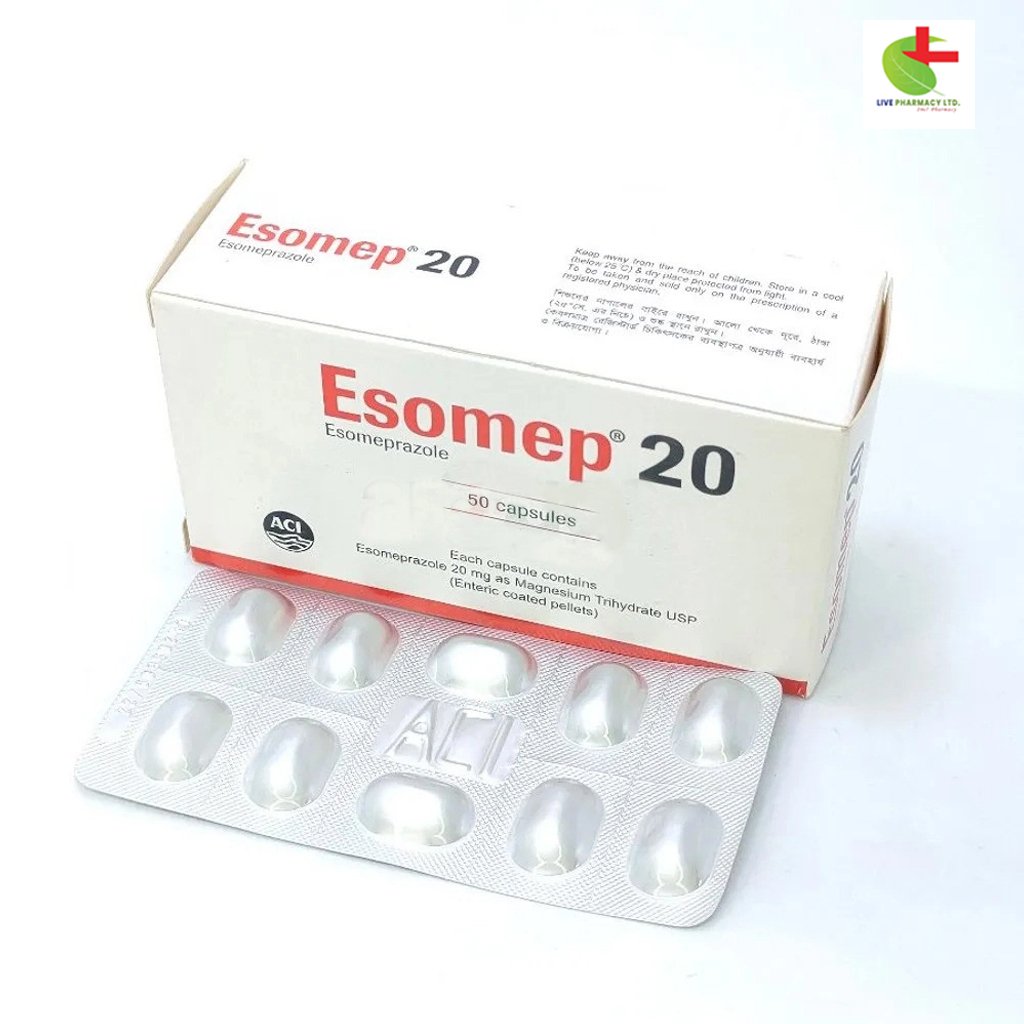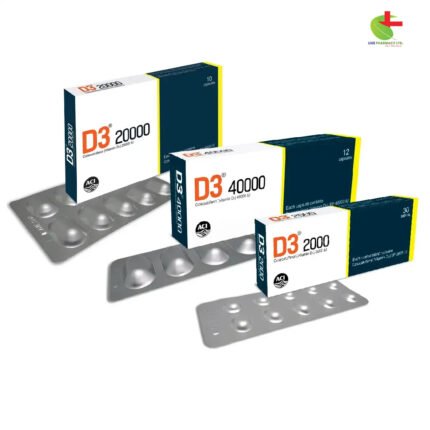Esomep 20
70.20৳ Strip
- Esomep (Esomeprazole) is a proton pump inhibitor used to treat GERD, erosive esophagitis, duodenal ulcers, and Zollinger-Ellison Syndrome.
- Reduces stomach acid production, aiding in healing and preventing recurrence of acid-related conditions.
- Available in both oral and IV formulations.
- Should be taken as directed by a healthcare provider for best results.
- Always consult a doctor before use.
 Brand
Brand
|
ACI Limited |
|---|---|
 Generics
Generics
|
Esomeprazole |
 Type
Type
|
Capsule |
Indications
Esomep is used for the treatment and management of various gastrointestinal conditions, including:
- Relief from chronic heartburn and symptoms associated with GERD (Gastroesophageal Reflux Disease)
- Healing and maintenance of erosive esophagitis
- Treatment for Helicobacter pylori infection, often in combination with amoxicillin and clarithromycin, to aid in duodenal ulcer healing
- Zollinger-Ellison Syndrome, a condition characterized by excessive stomach acid production
- Acid-related dyspepsia (indigestion)
- Duodenal and gastric ulcers
Always consult a healthcare provider before use.
Pharmacology
Esomeprazole is a potent proton pump inhibitor (PPI) that works by inhibiting the H+/K+-ATPase pump in the gastric parietal cells, reducing gastric acid production. As the S-isomer of omeprazole, it provides enhanced acid control, offering more effective treatment than traditional proton pump inhibitors.
Absorption:
Esomeprazole is rapidly absorbed after oral administration, with peak plasma concentrations reached in about 1.5 hours. Its bioavailability increases with repeated doses, achieving approximately 90% systemic absorption.
Metabolism and Excretion:
Esomeprazole is primarily metabolized in the liver by the CYP enzyme system, with most of the drug excreted in the urine as inactive metabolites. The drug has a half-life of 1–1.5 hours and is minimally excreted unchanged in the urine.
Dosage and Administration
For Oral Administration:
- Erosive Esophagitis Healing: 20 mg to 40 mg once daily for 4 to 8 weeks. An additional 4-8 weeks may be needed for patients who do not fully heal.
- Maintenance of Healing: 20 mg once daily (long-term use up to 6 months).
- Symptomatic GERD: 20 mg once daily for 4 weeks. An additional 4 weeks may be considered if symptoms persist.
- Helicobacter Pylori Eradication (Triple Therapy): 40 mg once daily, combined with Amoxicillin 1000 mg twice daily and Clarithromycin 500 mg twice daily for 10 days.
- Zollinger-Ellison Syndrome: 20 mg to 80 mg daily, dosage adjusted based on individual needs.
- Duodenal/Gastric Ulcers and Dyspepsia: 20 mg to 40 mg daily for 2–4 weeks.
IV Injection/Infusion:
- Erosive Esophagitis and GERD (Adults): 20 mg or 40 mg once daily, administered via IV injection (over 3 minutes) or infusion (over 10-30 minutes).
- Pediatric Patients: Dosage based on body weight (10 mg to 20 mg once daily).
- Post-Endoscopy for Ulcer Rebleeding (Adults): 80 mg initial dose via IV infusion, followed by continuous infusion of 8 mg/h for 72 hours.
Drug Interactions
Esomeprazole may interact with other medications metabolized by the CYP enzyme system, particularly CYP2C19. Co-administration with diazepam can reduce its clearance, potentially increasing its plasma concentration. Esomeprazole may also alter the absorption of drugs like ketoconazole and iron salts, where gastric acidity plays a key role in their bioavailability.
Contraindications
Esomeprazole is contraindicated in patients with known hypersensitivity to esomeprazole or any component of the formulation.
Side Effects
Common side effects may include:
- Headache
- Diarrhea
- Nausea
- Abdominal discomfort
- Constipation
- Dry mouth
Long-term use or maintenance therapy (up to 12 months) may not result in a significant increase in adverse effects.
Pregnancy and Lactation
Esomeprazole has not been extensively studied in pregnant women, although animal studies have shown no teratogenic effects. It is not known whether esomeprazole is excreted in breast milk. Discontinue breastfeeding if esomeprazole use is considered essential during lactation.
Precautions & Warnings
- Esomeprazole therapy does not rule out the presence of gastric malignancy, and symptoms should be carefully monitored.
- Geriatric Use: No significant difference in safety between elderly and younger individuals has been observed, but older individuals may show greater sensitivity.
- Hepatic Insufficiency: No dosage adjustments needed for mild to moderate liver impairment; however, the maximum dose for severe liver impairment should not exceed 20 mg daily.
- Renal Insufficiency: Minimal effect on pharmacokinetics in patients with renal impairment.
Storage Conditions
Store at room temperature (not exceeding 30°C) in a dry place, away from light and moisture. Keep out of reach of children.













Reviews
There are no reviews yet.